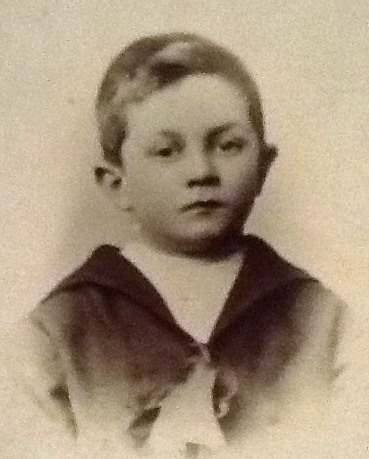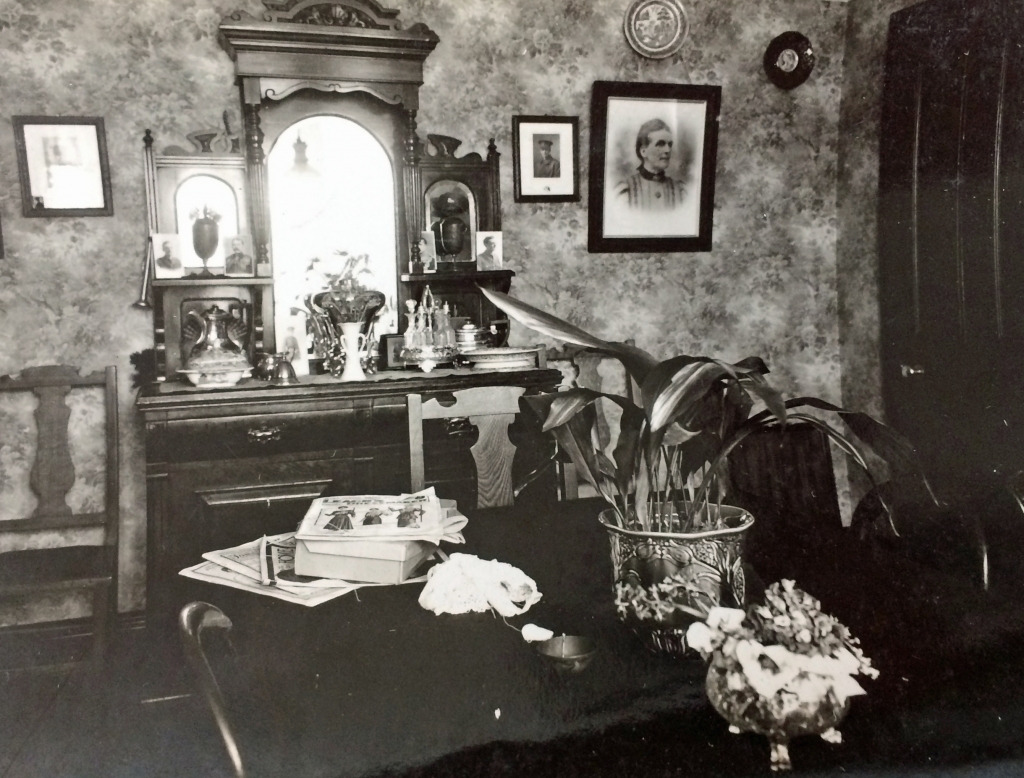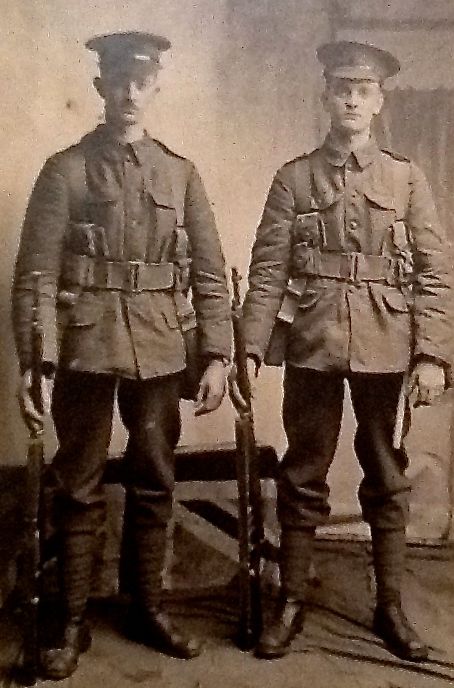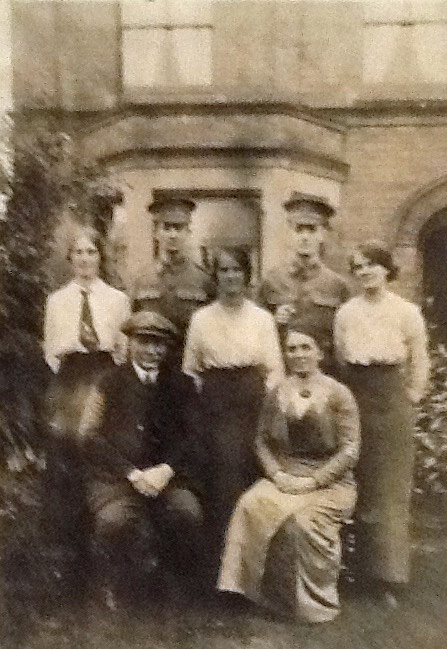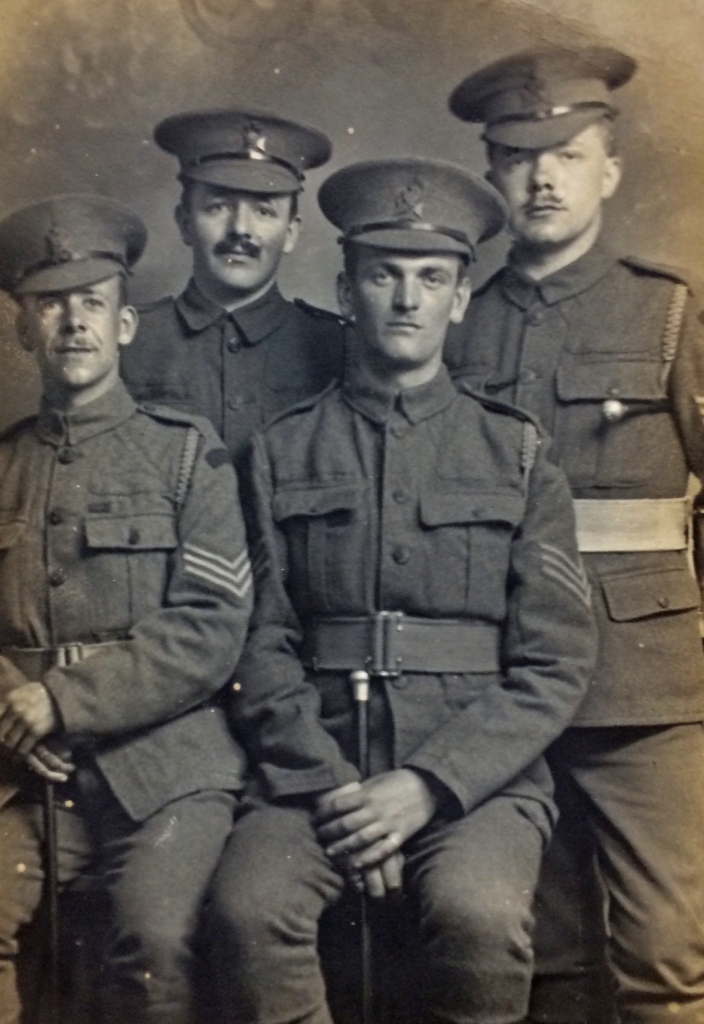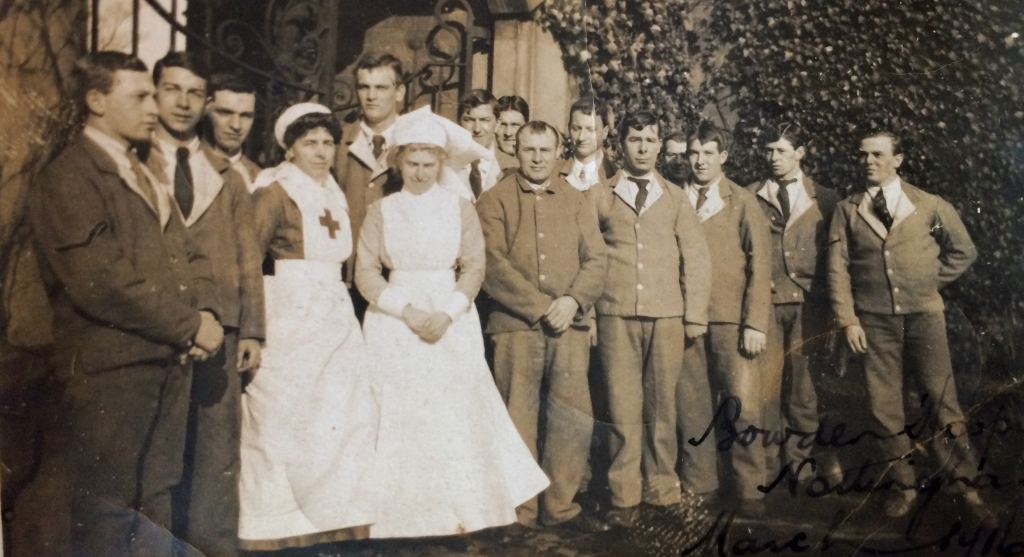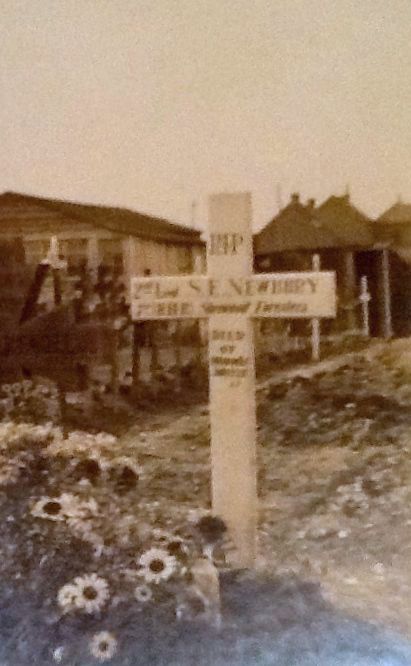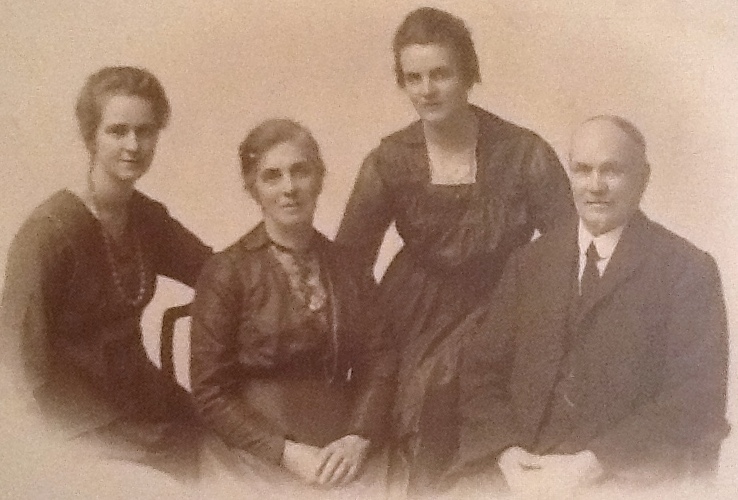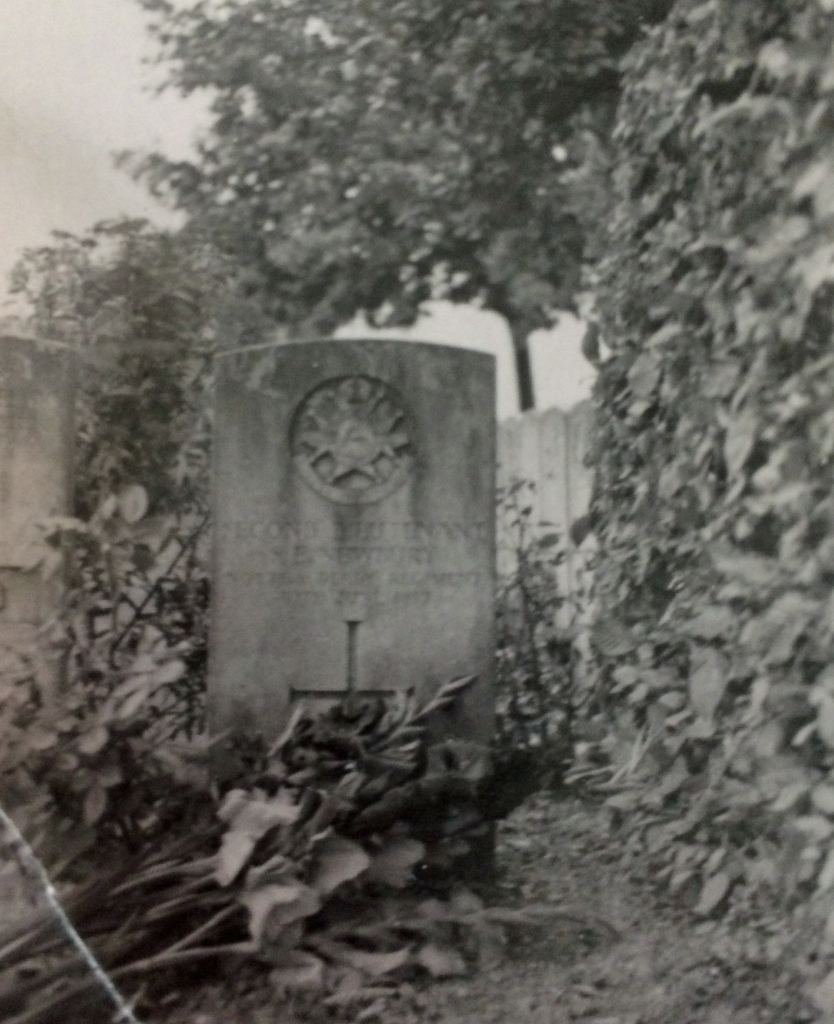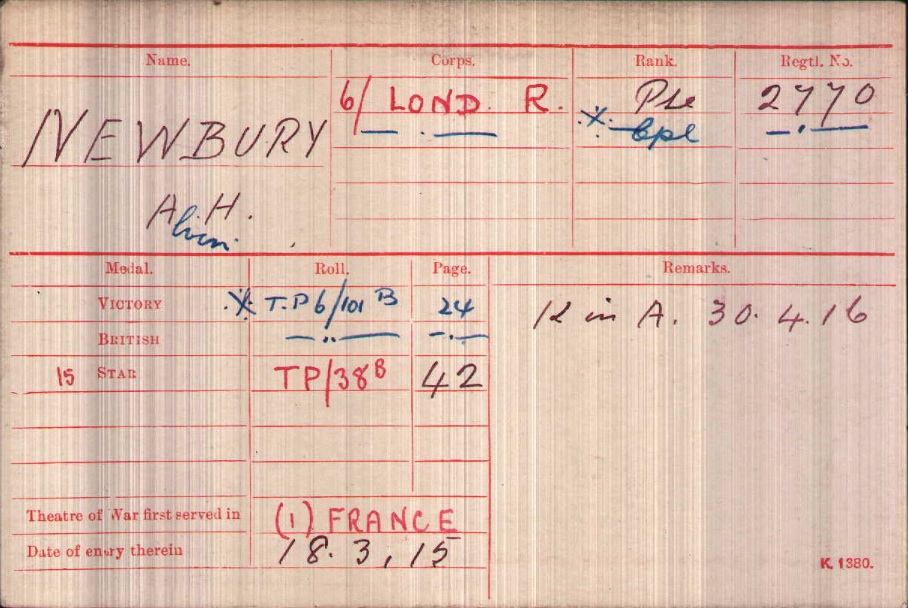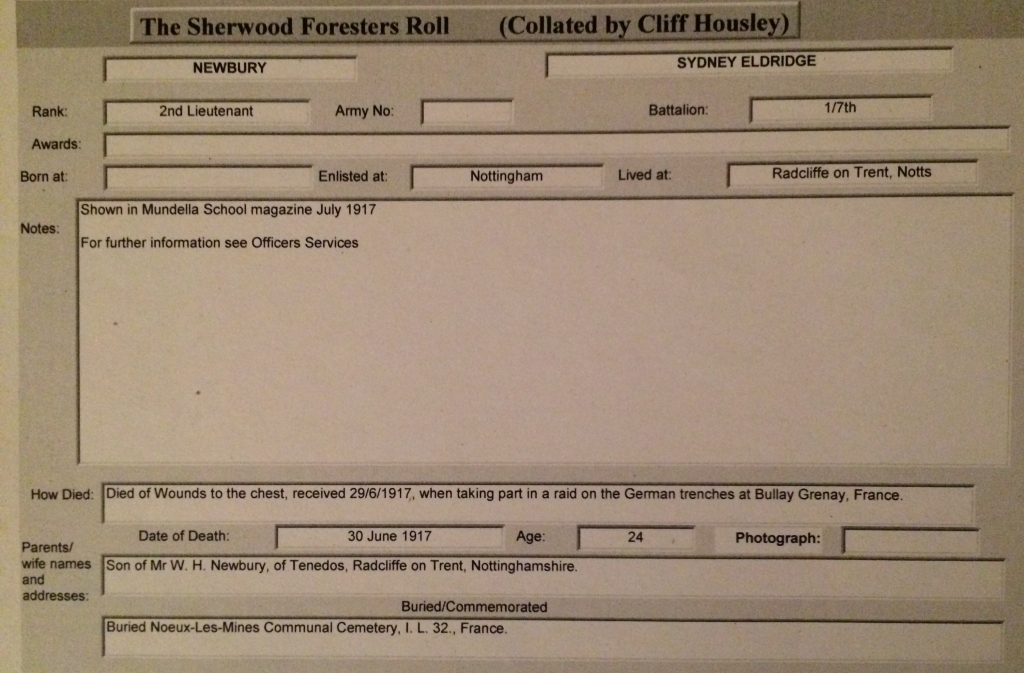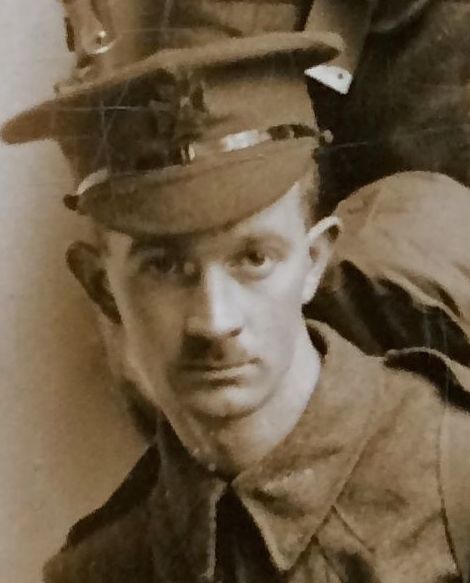A Tribute to Sydney Newbury 1893–1917
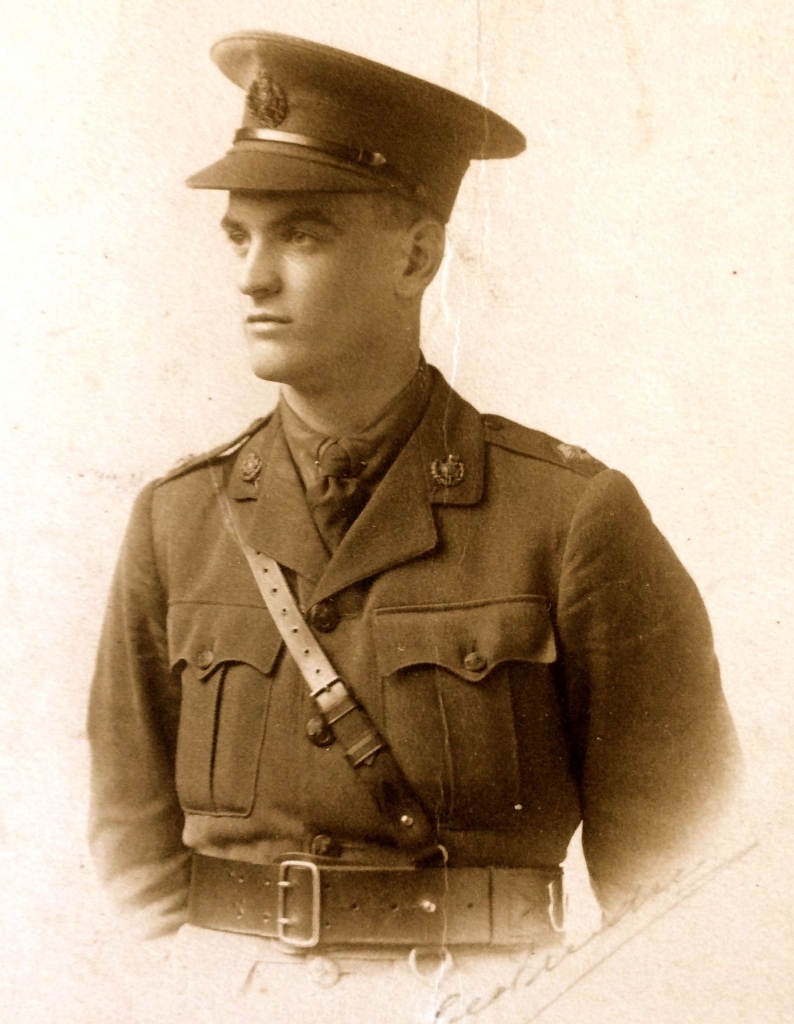
June 2017 marks the centenary of the death of Radcliffe on Trent serviceman 2nd Lieutenant Sydney Eldridge Newbury. His sister’s descendants have shared their memories and photographs with the Radcliffe on Trent WWI researchers, enabling them to compile this tribute.
Sydney Newbury was born on April 16th 1893 in Doncaster. He was the third child of William and Elizabeth Newbury. His father worked on the railways, initially as a goods guard and then as an inspector. Sydney’s elder brother Alvin was born in 1889 and sisters Grace Daisy and Ada were born in 1890 and 1894.
Sydney as a young boy
The family moved to Radcliffe on Trent in the early 1900s when William was transferred to a new railway post. They lived at ‘Tenedos’ on Cropwell Road, an eight-roomed red brick Victorian house.
Inside ‘Tenedos’, Cropwell Road, Radcliffe
The Newbury children were all educated at Mundella Higher Grade School and School of Science, Collygate Road, Nottingham. The school opened in 1899 and had 502 places for boys and 402 places for girls. It was named after Anthony John Mundella, a prominent Nottingham manufacturer, Chartist, Liberal M.P. and passionate advocate of compulsory education. The school became a grammar school in the 1920s.
By 1911 both sons had left school and were employed in clerical jobs. Sydney was working in the lace industry and Alvin for the railways where his father was now an inspector. Grace Daisy (always known as Daisy) was training to be a teacher at University College, Nottingham. Ada, age sixteen, was working as a pupil teacher at Mundella School
Sydney moved to London in 1912, having obtained a job at insurance brokers Lloyds. He lived with his aunt Mrs Jane Summers at 104 Sussex Road, Holloway. The Newbury family were devout Methodists and Sydney remained attached to the fellowship after he moved. He volunteered to work at a London Mission Sunday School where he formed a friendship with the Assistant Secretary, Percy Lloyd.
When war was declared the two men, together with Sydney’s brother Alvin, enlisted promptly in the 1st/6th City of London Battalion (Rifles) on September 7th 1914.
Alvin (left) and Sydney Newbury
The 1st/6th City of London Rifles was also known as the Cast Iron 6th. It was part of the London Regiment, a territorial force unit where different companies within it were associated with particular London employers. The 1st/6th moved to Watford in November 1914 where Alvin and Sydney trained with them before embarking for France in March 1915.
The Newbury family outside ‘Tenedos’, before Alvin and Sydney left for the Front.
Alvin is to the left with his fiancée. Sydney is to the right behind his sisters
The Newbury brothers sailed from Southampton to Le Havre aboard the SS La Marguerite on March 17th 1915 and proceeded to Béthune for training in trench warfare. Percy Lloyd was to join the Cast Iron 6th later in August. Sydney was promoted and made Corporal in May 1915. At the time his unit was being heavily shelled while holding the line adjacent to attacks at Festaubert. His next major engagement was at the Battle of Loos in September. Although his battalion achieved its objectives, there were many casualties. Sydney was made Sergeant in October of that year.
Sydney Newbury seated centre with fellow sergeants, 1915
He was wounded during a concentrated attack on the Hohenzollern Redoubt involving gas warfare which took place from 13-19 October 1915. He was invalided back to England in November, leaving Alvin behind fighting in France. He had serious internal injuries resulting in a major operation and a prolonged course of medical treatment. The latter part of his recovery took place at Bowden Auxiliary Hospital, Mapperley Road, Nottingham, not far from Radcliffe on Trent.
Sydney Newbury standing behind two nurses at Bowden Auxiliary Hospital, Nottingham
By this time the men the Newbury sisters were later to marry were stationed abroad. Daisy’s boyfriend Harry Sketchley lived opposite the Newbury family home in Radcliffe at Lenton House, Cropwell Road. He departed for Africa shortly after the outbreak of war to work there as a Methodist minister. Ada met her fiancé William Ecob when they were at Nottingham University; he was a friend of her brothers. William interrupted his studies to enlist and soon became an officer. He left for the Front with the Green Howards in August 1915.
Sydney spent 1916 in the U.K. recovering from his wounds. The family were devastated when Alvin Newbury was killed on April 30th in a mine explosion at Vimy Ridge. The location is now known as Mildren Crater after Commanding Officer. Lt. Colonel W. Mildren, who managed to occupy and fortify it. William Ecob’s son told the Radcliffe on Trent WWI researchers that his father met Alvin unexpectedly in a trench shortly before the explosion. The brief encounter followed by the shocking news contributed towards William suffering from shell shock later on. More tragedy was to come for Sydney when his friend Percy Lloyd was killed in September during the Battle of the Somme.
In July 1916 Sydney was well enough to be attached to the 6th Reserves (Officer Cadet Battalion) London Rifles. He received his commission as 2nd Lieutenant in the 1st/7th Sherwood Foresters (Robin Hoods) on October 24th. Sydney returned to the Front at the beginning of January 1917. He joined the Robin Hoods at Foncquevillers and was involved in operations on the Ancre in March. Back home his sister Daisy, a Nottingham University College V.A.D. member, was now working as a part time unpaid nurse at the Pavilion Auxiliary Hospital, Trent Bridge cricket ground. Ada had completed her teacher training and was combining teaching with work as a V.A.D.
In France, Sydney was leading No. 4 Platoon of the Robin Hoods, He kept a photograph of three platoon members among his possessions. On the back of the photograph below, he wrote, “Three of my very best taken about ten days ago. Unfortunately only the centre one is left.”
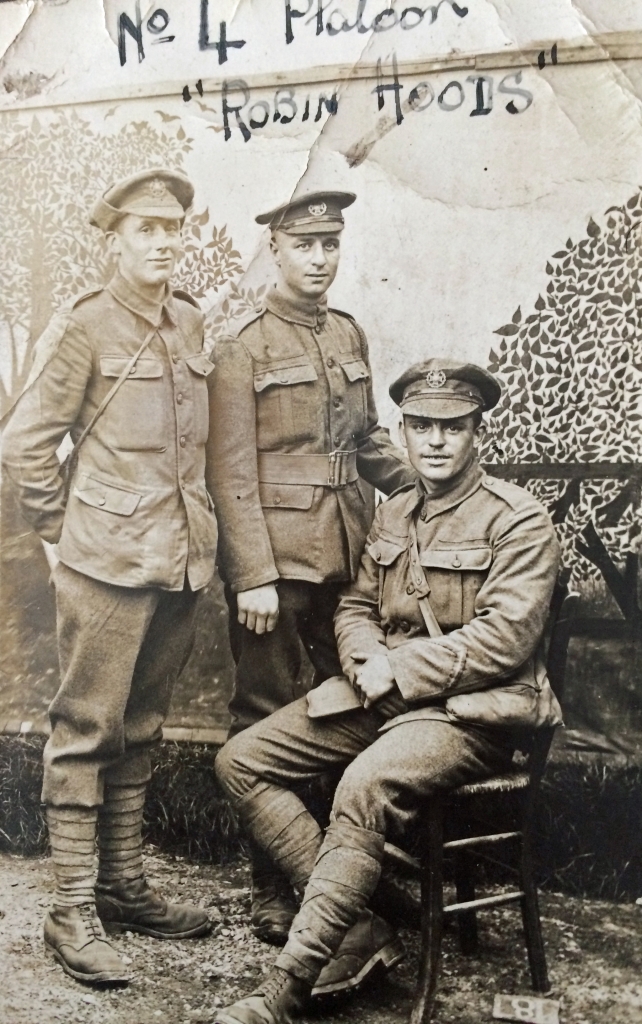 Members of No.4 Platoon, 1st/7th Sherwood Foresters
Members of No.4 Platoon, 1st/7th Sherwood Foresters
On June 30th Sydney Newbury was involved in action which cost him his life. The 1st/7th Sherwood Foresters (Robin Hoods) were at Bully Grenay, a small town north of Arras and south of Béthune which was under heavy bombardment from the Germans.
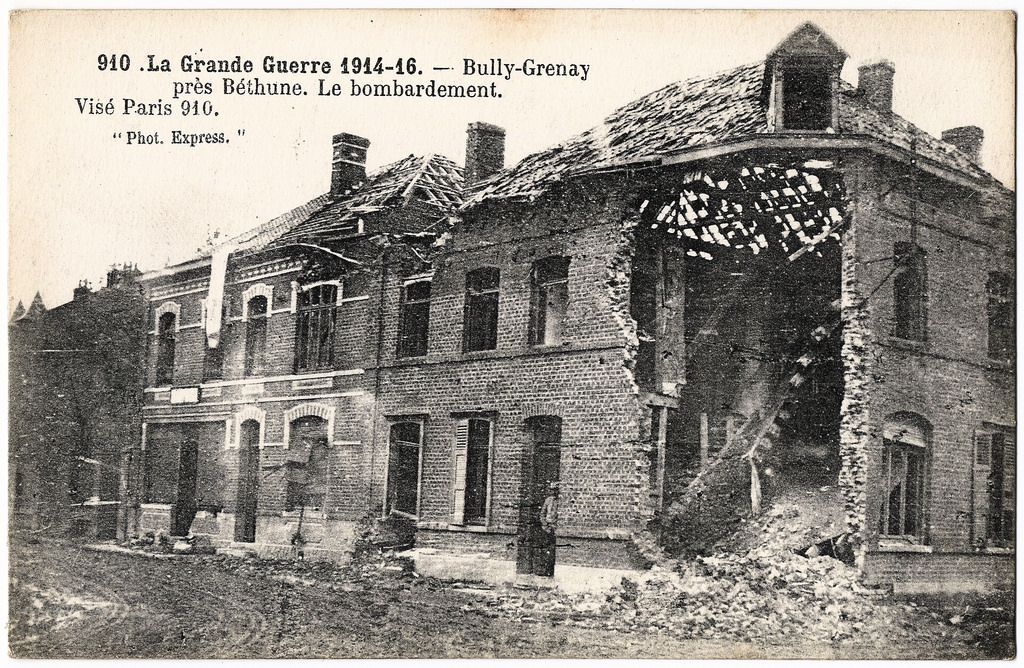 Bully Grenay at the time of the German bombardment
Bully Grenay at the time of the German bombardment
He was fatally wounded in the early hours of June 30th 1917 during a raid on German trenches and died a few hours later at No. 7 casualty clearing station. One of his fellow officers wrote to his parents as follows:
“On June 30th at 2.44 a.m. our battalion attacked and took the German trenches at point. Within a few minutes of the attack being launched your son was leading his men through the last belt of German wire, just into the first line of German trenches, when he was dangerously wounded through the left lung with a piece of shrapnel. His servant carried him into a shell hole, when his wound was dressed immediately by our stretcher bearers. Shortly after, he was carried on a stretcher to a field dressing station, and thence by motor ambulance to the Casualty Clearing Station. About 5.30 p.m. he fell into a peaceful sleep from which he never awoke, for he gently passed away about 7.15 p.m. He was cheerful and conscious to the last and was talking of getting home again. Syd was one of the very best and was loved by his men, and was one of those who did not know what fear was.”
(Source: private papers belonging to his descendants)
Sydney Newbury’s grave at Noeux les Mines
Sydney was buried at Noeux les Mines cemetery which was used by No. 7 casualty clearing station from April 1917 onwards. The cemetery contains 980 Commonwealth burials of the First World War including twenty-nine men from the Sherwood Foresters. He was twenty four years old. Today, the Sherwood Foresters who fell at Bully Grenay are remembered in the twinning link between Bully-les-Mines and Ruddington, a village eight miles from Radcliffe on Trent.
Two months after Sydney’s death Captain William Ecob returned home in September diagnosed with neurasthenia (shell shock). He had been fighting on the Western Front for over two years and, among other comrades, had lost his friends the Newbury brothers. Doctors concluded that he was “suffering from nerves and debility, probably caused by prolonged active service … he is need of a few weeks of complete rest”. He married Ada Newbury the following month in the Methodist Chapel, Radcliffe on Trent. In May 1918 the Medical Board decided he was fit for home service. The couple moved to Hastings where William had been transferred as an instructor with the Royal Flying Corps. There he met Bertie, later King George VI; the two men played tennis and went for runs together. Daisy also moved down to Hastings where she continued working as a V.A.D. The Ecobs and Daisy remained there until the end of the war in 1918. William and Ada Ecob then returned to Radcliffe on Trent so William could complete his chemistry degree at Nottingham University.
The Newbury family after the deaths of Alvin and Sydney.
Ada, left, mother Elizabeth, Daisy (standing) and father William
In 1920 Daisy sailed to Cape Town where she married Harry Sketchley, who was still a Methodist minister based in Africa. The couple lived in Rhodesia (now Zimbabwe) until the 1930s when they returned to England.
On Armistice Day 1920, Mundella School unveiled a bronze memorial plaque commemorating the 120 old boys who lost their lives in the Great War. The Newbury brothers were among those whose names were read out from the Roll of Honour and inscribed on the memorial. After the school was demolished in 1985, the plaque went missing for fifteen years until it was eventually tracked down by former pupils who found it in a primary school storeroom. It is now housed in St. Mary’s Church, Nottingham where it was re-dedicated in 2001.
Mundella School Memorial plaque, St Mary’s Church Nottingham.
Image courtesy of www.mundella.org.uk
Radcliffe on Trent War Memorial was unveiled on March 27th 1921; Alvin and Sydney’s names were amongst those listed. On the day, around 250 ex-servicemen from the village paraded to the church where Colonel Birkin, C.O. of the Robin Hoods before being wounded in 1915, gave a moving speech. Buglers from Sydney’s former battalion sounded the Last Post.
William and Ada Ecob named the first and second of their four sons after the Newbury brothers. Alvin Keith was born in 1919 and Gordon Sydney was born in 1924. They moved from Radcliffe on Trent to North London in the early 1920s. Ada’s parents, William and Elizabeth Newbury, also left the village to live near their daughter and grandchildren; they both died in Middlesex in the early 1930s. In 1937 William Ecob took his family to France where they visited Sydney’s grave at Noeux Les Mines. There is no grave for Alvin: his body was not recovered and he is remembered on the Arras Memorial. The brothers continue to be remembered in the family to this day through the double barrelled surname Newbury-Ecob.
Sydney Newbury’s grave in 1937 with C.W.G.C. headstone
Half of Sydney’s short military career was spent in highly charged dangerous situations on the Western Front and the other half recovering from serious wounds. He was exposed to much physical and emotional trauma; his story together with the photographs of him during the war suggests he met those monumental challenges with resolution and courage.
Researching the Newbury family
Discovering Sydney Newbury’s story has been a lengthy process. When the Radcliffe on Trent WWI project began, an initial aim was to uncover the identities of those from the village who lost their lives as a result of the war. The local memorial does not note men’s ranks or regiments; the four members of Radcliffe WWI research team have spent many hours delving into all their personal and military histories.
We began investigating the Newbury story by examining the 1911 Census where we found the family living on Cropwell Road. We then explored the Medal Rolls Index Cards on Ancestry and summaries on Forces War Records to establish basic details about Alvin and Sydney’s military units, ranks and service numbers.
Alvin Newbury’s Medal Rolls Index Card from www.ancestry.co.uk
The website www.longlongtrail.co.uk, Forces War Records and Wikipedia revealed details about major engagements undertaken by the 1st/6th London City Rifles and 1st/7th Sherwood Foresters during the war. We studied the 1915 War Diaries for the London City Rifles to gain a fuller picture.
We then visited the Sherwood Foresters Regimental Museum Archives at Chilwell to consult records for all the Sherwood Foresters we were researching, including Sydney Newbury. Officers’ records are currently unavailable online – it was at the archives we discovered a note concerning Sydney’s death at Bully Grenay.
Sydney Newbury’s military record from the Sherwood Foresters Roll, collated by Cliff Houseley
Around this time we were exploring Red Cross V.A.D. records and discovered Ada and Daisy Newbury were both attached to the 96th Voluntary Aid Detachment of University College Nottingham. A trip to the university archives resulted in the discovery of Ada and Daisy’s teacher training college records. A visit to the National Archives at Kew produced more information about Sydney Newbury’s war service as well as William Ecob’s military record, which included details from his medical records and transfer to the Royal Flying Corps.
We attempt where possible to interview descendants of those whose stories we are exploring. Finding the Newbury-Ecob family was not an easy matter but eventually we discovered William Ecob’s third son living in the south of England. Email contact followed by a visit has brought all the stories to life. He provided us with an abundant amount of information and gave us full access to the family photographs, some of which are reproduced here. Before the visit we were unaware of key elements in the story, such as the friendship between William Ecob and the Newbury brothers, Daisy’s marriage in South Africa and the officer’s letter describing Sydney’s death. We are very grateful for all the assistance the family has given us to help construct the Newbury and Ecob stories.
The remaining details in Sydney Newbury’s tribute, such as the brief history of Percy Lloyd’s military career, the CWGC cemeteries in France and the story of Mundella school WWI memorial plaque have been gleaned from online resources. Finally, we have put much effort into reproducing faded, creased or out of focus photographs so that they could conform as closely as possible to the standards of our website.
Why have we written a tribute for Sydney Newbury and not for his brother Alvin?
Alvin Newbury, London City Rifles
Although Sydney’s story is no more tragic than Alvin’s, who was killed in 1916, we focused on Sydney because we had more information about him. Sydney’s enforced hospitalisation in the U.K. produced several photographs of him with fellow patients together with other memorabilia. Alvin’s story is more hidden. Not all WWI service records for other ranks are available online; Alvin’s is one of the missing ones. He could well have become an officer had he lived longer but the fact that his younger brother Sydney was commissioned in 1916 means that his officer’s record has been preserved whereas Alvin’s has been lost. In addition we felt it was appropriate to commemorate the centenary of Sydney’s death in June 1917.
Rosemary Collins, June 2017
Click on the links below to read the biographies of Newbury and Ecob family members:

